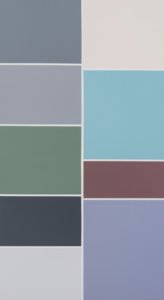
- Manía – 150 x 82 cm
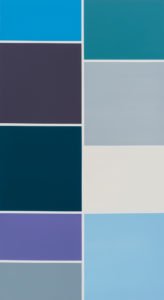
- Zoloft – 150x 82 cm

- Ansiedad – 150 x 82 cm

- Lindormin – 150 x 82 cm
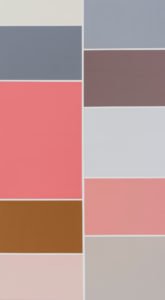
- Adicciones -125 x 69 cm

- Xanax – 125 x 69 cm
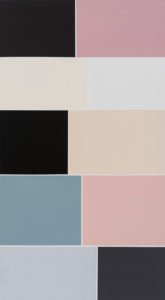
- Depresión – 125 x 69 cm

- Dormicun – 125 x 69 cm

- TEPT – 100 x 75 cm

- Agorafobia – 100 x 75 cm
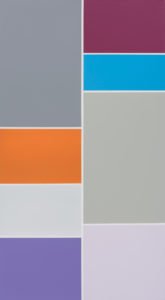
- Ativan – 100 x 55 cm
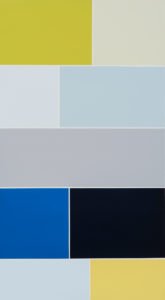
- Cymbalta – 100 x 75 cm

- Effexor – 75 x 41 cm

- Psicosis – 75 x 41 cm

- Bipolaridad – 75 x 41 cm
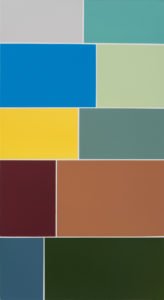
- Prozac – 75 x 41 cm
Imagen: 3
Fotografías de Oscar Monsalve
El diagnóstico de enfermedades mentales, así como el consumo de medicamentos para tratarlas es más común de lo que se cree. Sin embargo, poco o nada de habla del tema. Como artistas pensamos que al traducir al lenguaje pictórico estas enfermedades y medicamentos se podrá poner el tema sobre la mesa sin tantos tabúes o prejuicios.
Encontramos que, al hacer búsquedas en internet a través de Google Imágenes, antes que las imágenes estén totalmente cargadas en la pantalla, el sistema realiza automáticamente una síntesis de color. En este proceso, en la pantalla aparecen unos recuadros que incluyen el color preponderante de cada una de las imágenes correspondientes a la búsqueda y una composición que depende del tamaño de cada una de estas imágenes. Con la inquietud inicial de las enfermedades mentales y esta ‘herramienta’ de google, hicimos búsquedas de diversas patologías o situaciones mentales y los medicamentos siquiátricos que existen para tratarlas. Para así hacer la traducción al lenguaje pictórico de estas.
Las pinturas hechas en acrílico corresponden a las enfermedades. Esto debido a la intención de contrarrestar, metafóricamente, la enfermedad con el ejercicio manual y constante de pintar. En contraste, las pinturas de los medicamentos están hechas en esmalte. Esto se debe al carácter industrial de la producción y distribución de los medicamentos psiquiátricos. El tamaño de todos los cuadros es proporcional al de la pantalla de un celular Smartphone debido a que a esta tecnología se le ha atribuido, en los últimos años, la causa de muchas de las enfermedades mentales. Principalmente por el aislamiento que genera en las personas.
Por ultimo, al hacer esta traducción a color de enfermedades psiquiátricas y sus medicamentos quisimos que las pinturas fueran lo más limpias y exactas posibles. Esto con la intención de resaltar que aquellos que sufren de una de estas enfermedades tienen que mostrarse, en apariencia, muy estables y perfectos, aunque sin que sea aparente, están lidiando y escondiendo una enfermedad de la que poco o nada se habla.
Este proyecto es en co-autoría entre María Jimena Herrera e Iván Cardona
The diagnosis of mental illnesses, as well as the consumption of medications to treat them, is more common than believed. However, little or nothing is spoken of. As artists, we think that by translating these diseases and medicines into a pictorial language, we will be able to converse more about them without as many taboos or prejudices.
We found that, when looking across the internet through Google Images, the system automatically generates a color synthesis before the images are fully loaded on the screen. In this process, the screen reflects each image as a single-colored box reflecting the predominant color of the image. The composition of the screen depends on the size of each image. Given the initial concern about mental illnesses and this google 'tool', we searched for various pathologies or mental ailments and the psychiatric medications that exist to treat them. This was then used as the medium for the translation of our pictorial language.
The paintings made with acrylic paint correspond to the diseases. This was done with the intention of metaphorically counteracting the disease with the manual exercise of painting. In contrast, the paintings of medications were made with enamel. This is due to the industrial nature of the production and distribution of psychiatric drugs. The size of all the canvas is proportional to the screen of a Smartphone: a technology that has been attributed in recent years to be a cause of many mental illnesses. This is primarily because of its ability to make people feel isolated.
Finally, in making this color translation of psychiatric illnesses and their medications, we wanted the paints to be as clean and accurate as possible. This was done with the intention of highlighting that those who suffer from one of these diseases often times give the appearance of stability and perfection, despite that they are internally dealing with a disease of which little or nothing is said.
This project is in co-authorship with Iván Cardona
